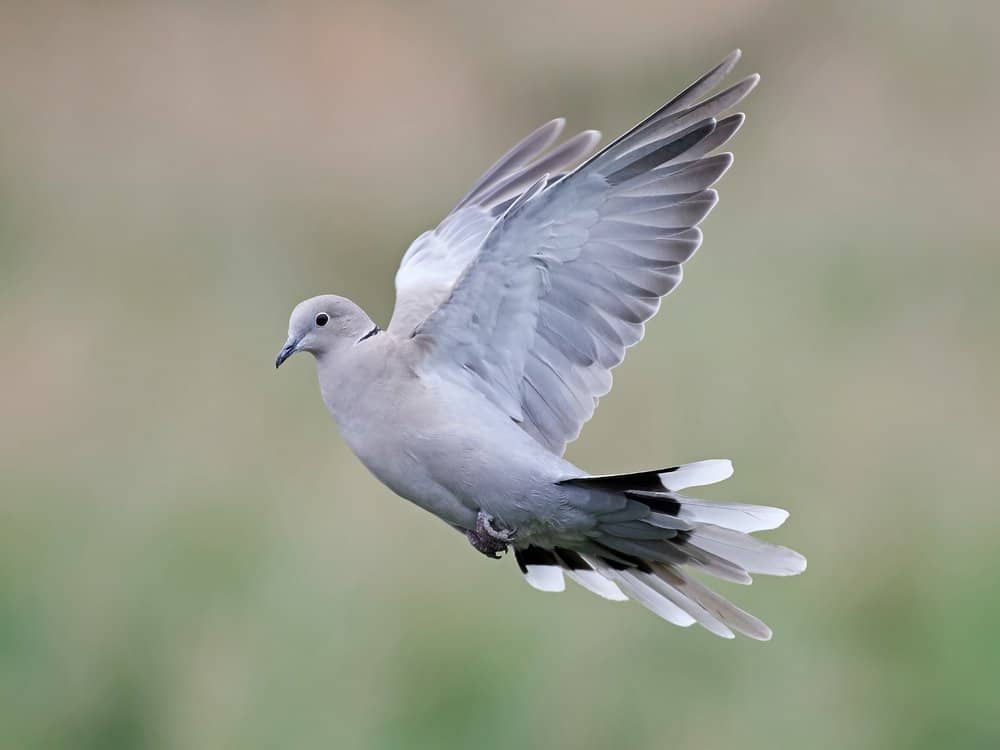
Plants and animals brought to a region outside of their native range and that cause damage there are referred to as invasive alien species. They often spread rapidly because they have no natural predators or factors that control their reproduction. One of the biggest dangers to biodiversity is invasive alien species, which also tremendously burden human health and other human endeavors like agriculture, forestry, and fisheries. And it’s not cheap, either. In general, the overall cost to keep invasive alien species under control throughout the continental United States is estimated at over $137 billion dollars per year. The invasive birds of California take up quite a bit of that budget.
The state of California has a serious problem when it comes to invasive bird species. In this guide, we’ll explore nine common invasive bird species in California and why their naturalization in the state’s ecosystem is potentially dangerous.
Why Are Invasive Birds Such A Problem?
Hundreds of years ago, invasive birds made their initial appearance in North America. Since then, a constant stream of introductions, both planned and unplanned, has increased their numbers. There are currently self-sustaining colonies of about 100 non-native bird species in the United States, many of which are in California.
So why exactly are invasive birds such a problem? The introduction of birds may have a variety of ecosystem-level consequences, such as eutrophication of water bodies due to increased bird dropping deposits and modifications in plant community composition and vegetation structure due to the introduction of novel mutualisms. Crops are destroyed by invasive birds, who also spread illness and outcompete local birds for food, nesting locations, and breeding grounds. When competing for nest boxes, introduced house sparrows, for instance, will often drive out and even kill native species like bluebirds and other sparrows. Native plants and animals can even go extinct as a result of invasive species. They can also damage biodiversity, cause a lack of resources for native birds, and disrupt whole ecosystems. To put it simply, invasive birds have significant negative economic effects and can alter California’s coastal ecosystems.
In some circumstances, it is necessary to control invading birds, and some organizations have implemented anti-invasive regulations. As avian reductions spread across North America during the past half-century, some of the largest invading bird populations have declined, causing a loss of more than 3 billion birds to the world’s bird population. Despite these significant declines, invading birds are still very much a part of our environment and are undoubtedly here to stay in California.
1. Common starling
Species: Sturnus vulgaris

The common starling (pictured) is known as one of the worst invasive species in the world.
©Petr Simon/Shutterstock.com
A medium-sized passerine bird, the common starling is sometimes referred to as the European starling in Great Britain and Ireland. It has glossy, metallic-shaded black feathers that occasionally have white spots throughout the year. Young birds have browner plumage than adults do; their legs are a peachy pink, and their bills are black in the winter and a bright yellow in the summer.
The common starling has been listed as one of the world’s 100 worst invasive species by the IUCN due to its contribution to the extinction of local native species and the harm it has caused to agriculture in North America and Australia. Because common starlings are habitat opportunists, they can use a wide variety of habitats, nesting locations, and food sources. They can take advantage of other local birds, most notably woodpeckers. They are often successful in using up other bird species’ food and nesting resources because they are lowland birds that get along well with humans and can be fearlessly aggressive with other bird species. In California and many other parts of the country, this has presented a major problem.
2. Red-masked Parakeet
Species: Psittacara erythrogenys

Also known as the Cherry-headed Conure, the Red-headed Conure or the Red-Masked Conure.
©iStock.com/passion4nature
The red-masked parakeet is a species of bird native to South America, specifically in the dry Tumbesian region of southwest Ecuador and northwest Peru. The most distinguishing characteristics of adult red-masked parakeets are the solid and widespread red hues on their heads, considerable red in their underwing coverts, and their overall small body size. Although this bird is regarded as invasive in California, it is near-threatened in its native South America.
One of the most common abandoned or wild parakeet species in California, especially in the San Gabriel Valley, this bird was introduced by the pet trade. In California, there are thought to be between 300 and 345 red-masked parakeets living in the wild, and their numbers can increase in due time. Instead of inhabiting natural settings, these parakeets are typically seen near exotic plants in suburban and urban parks. Although they can drive away indigenous flora and animals to the detriment of regional ecosystems, the magnitude of the harm they could cause to local bird and wildlife populations appears to be small.
3. Mute Swan
Species: Cygnus color
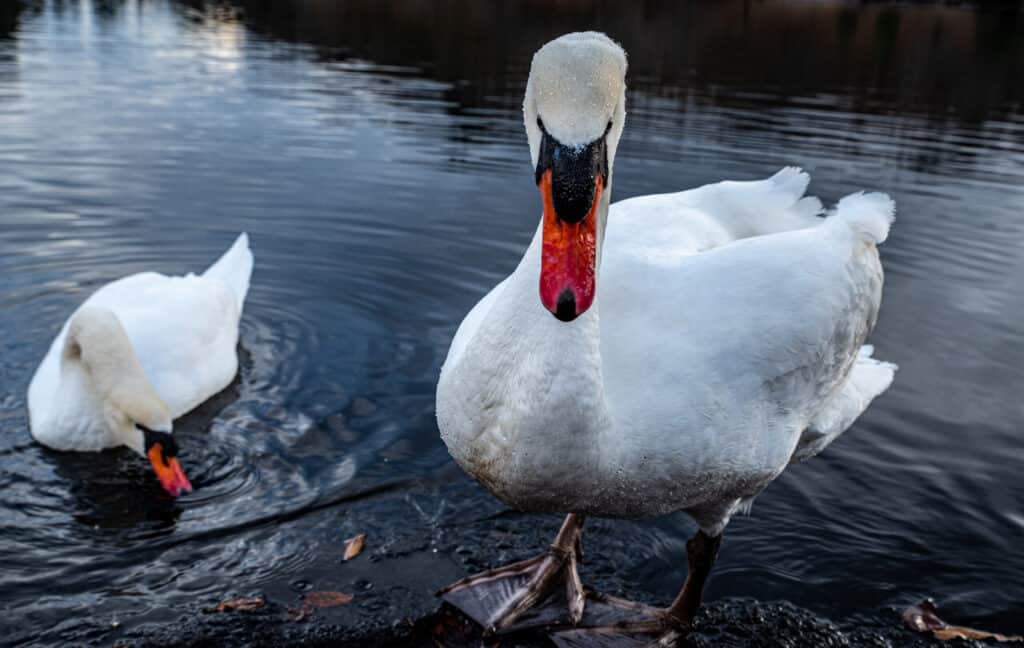
Mute swans (pictured) are largely invasive due to the fact that people will purchase them as ornamental birds.
©TETSU Snowdrop/Shutterstock.com
The mute swan is a species of swan that is indigenous to most of Europe and Asia. The whole body of this huge swan is white, and its orange beak is edged with black. It can be identified by the prominent knob on the bill. The mute swan maintains its neck in an elegant swooping curve when swimming, and its beak is pointed down. It’s one of the most easily identifiable bird species in the United States.
The mute swan has become so numerous after being brought to North America that it is now regarded as an invasive species. With less than 200 in each of New Zealand, Australia, and South Africa, and approximately 200 in Japan, the populations that have been brought to other regions outside of the US are still rather small. It isn’t abundantly clear why they have spread to high populations in the United States. They are hostile against other ducks and people in California and spread from ponds where they are kept by some as ornamental birds. They also devour aquatic vegetation that other species need in ecosystems around the coast of California.
4. Rock Dove
Species: Columba livia

Despite being an invasive species in California, rock doves have become crucial to the environment, particularly in the Bay Area.
©Opasbbb/Shutterstock.com
Rock pigeons, often referred to as rock doves, are indigenous to Asia, North Africa, and regions in Europe. They can come in a variety of colors, but the majority have banded wings, black tail tips, and iridescent neck feathers. Although city-dwelling rock doves and those living in urban areas also consume human food, they mostly eat seeds and fruit in the wild and the occasional insect.
Early in the 17th century, English settlers brought rock doves to North America. Soon after, the birds started their own colonization efforts and eventually covered the whole continent, much of Canada, and even sections of southern Alaska.
Despite a 46% reduction in population size over the last 50 years, it is still common to see rock pigeons in the United States, where there are thought to be 8.4 million of them. These birds are often seen in towns or on farms and do well with alterations to the natural environment. While they don’t actually do much to harm local bird populations, rock pigeons do carry a number of parasites and illnesses, including avian influenza. Despite being an invasive species in California, they have become crucial to the environment, particularly in the Bay Area.
5. House Sparrow
Species: Passer domesticus
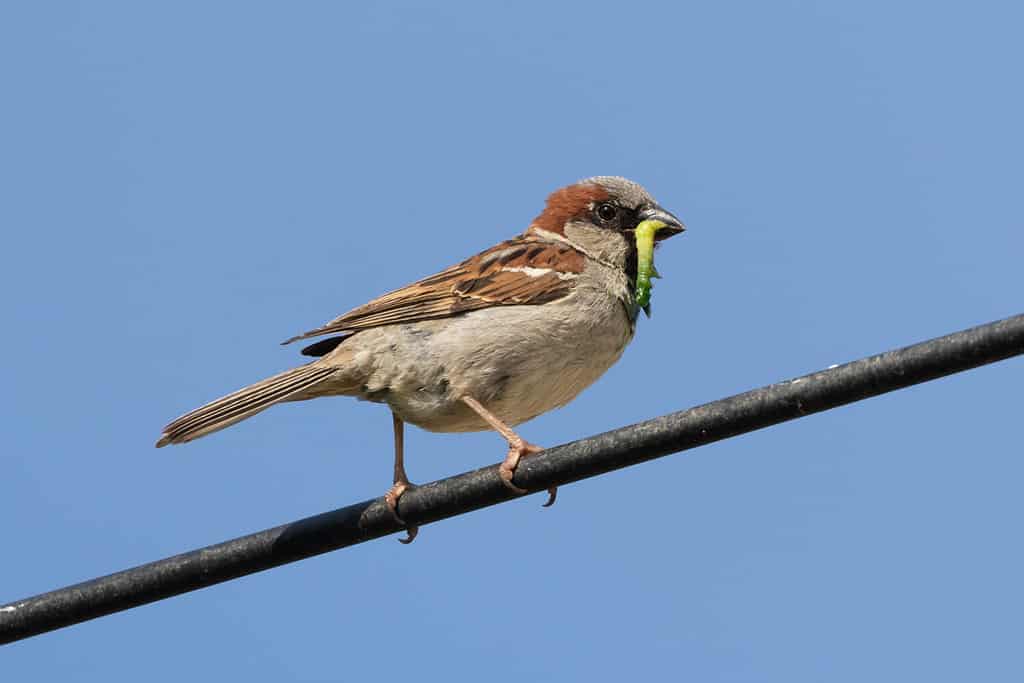
House sparrows, which were first located in Europe and Asia, are now among the most common birds in the world.
©Werner Baumgarten/Shutterstock.com
The house sparrow is a species of sparrow that stays fairly small and boasts and rounded head. Male birds have more vivid black, white, and brown patterns whereas females and young birds have a lighter shade of brown and grey.
The city of Brooklyn, New York first received house sparrows in 1851 in an effort to reduce caterpillar numbers and save the city’s basswood trees from invasive moths. By fewer than 50 years of its first release, this Old World songbird had colonized the whole North American continent. In California, it is regarded as an invasive species.
House sparrows, which were first located in Europe and Asia, are now among the most common birds in the world. They are among the most prevalent birds in the United States, with a population of around 7 million. Yet, this figure is very different from just 100 years ago, when it was predicted that there were 150 million house sparrows living in the nation. Although it seems that the industrialization of American farms may have something to do with it, the cause of their decrease is still not entirely understood. House sparrows are formidable competitors for breeding space in California, forcing native species out of nest boxes, and many farmers view them as pests.
6. Eurasian Collared Dove
Species: Streptopelia decaocto
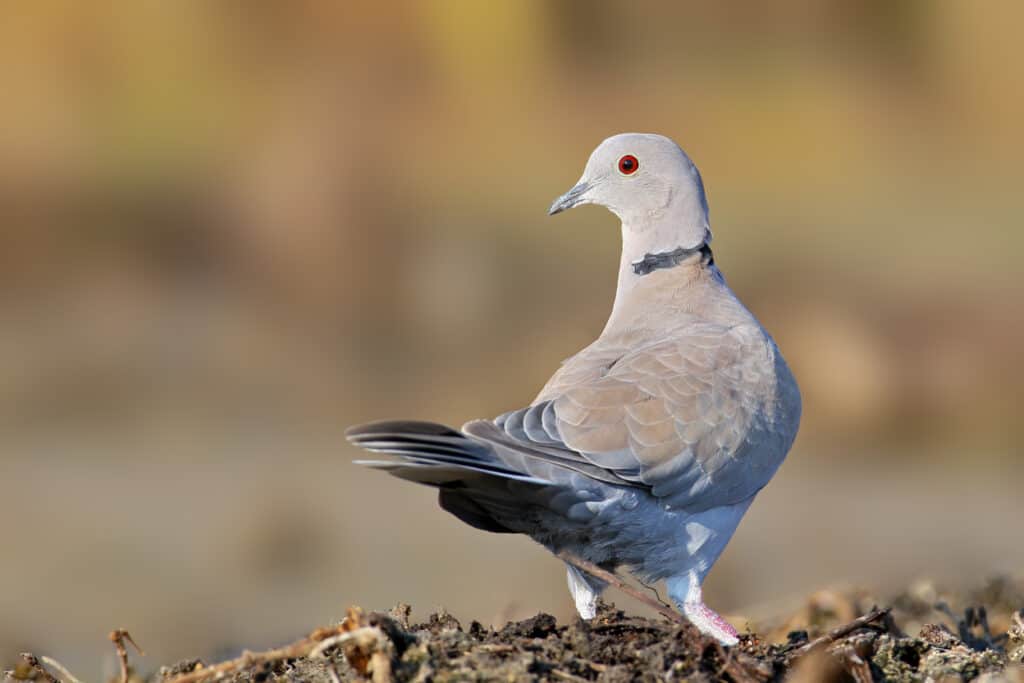
This dove has a tail that distinguishes it from some similar species in that it is squared off rather than pointed.
©Voodison328/Shutterstock.com
The Eurasian collared dove is a species of dove that originated in Europe and Asia. It has since been brought to Japan, North America, and the Caribbean islands. It is a medium to large-sized dove with a blue-grey underwing patch that is often grey to pink-grey, slightly darker above than below. The outer tail feathers are likewise tinged white above. The tail feathers of this bird are medium-grey above and a darker-toned grey with white tips.
The history of this species spread in the United States and thus, California is fascinating. In 1974, a pet store robbery in the Bahamas resulted in the first release of Eurasian collared doves into the wild. These large, pale doves spread across North America at a rate unparalleled by any invasive species after arriving in southern Florida in the 1980s. The majority of the United States is now home to Eurasian collared doves, which were once common from Turkey to Sri Lanka.
Nevertheless, they are still mainly missing from New England and the upper Midwest. Their 400,000-strong U.S. population has been expanding at a fast rate each year. Because Eurasian collared doves are new migrants, it is still too early to tell whether or not they will have an effect on California’s native birds. The impact seems to be modest so far, but as their populations increase along California’s coasts northward, that might change.
7. Japanese White-Eye
Species: Zosterops japonicus
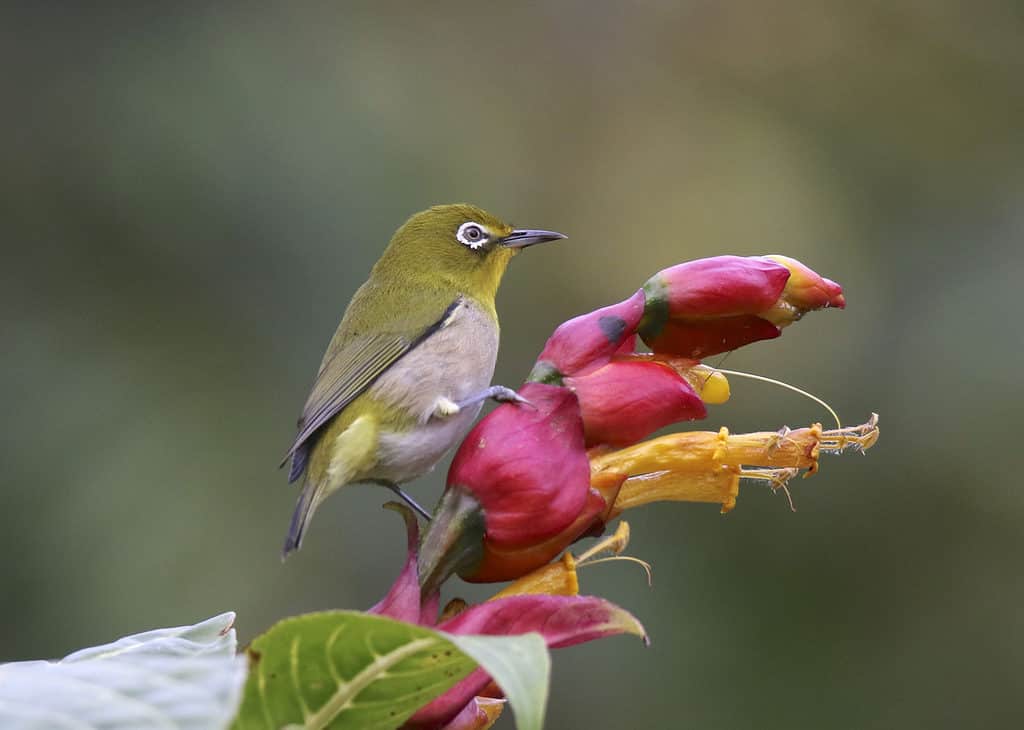
The Japanese white-eye (pictured) is invasive in Hawaii and California, though the extent of their damage or potential benefits are not yet known.
©iStock.com/Nancy Strohm
A kind of passerine bird, the Japanese white eye is often referred to as the mountain or warbling white-eye. From anterior to posterior, the back of this bird has an olive green color, while the underside is a pale green color. Its beak, legs, and feet are all shades of black and brown. It has a golden neck and a green forehead.
Most of East Asia, including eastern Russian, Japan, Korea, and other countries, make up the Japanese white-eye’s natural range. With varying degrees of success, this species has been purposefully brought to different regions of the world as a pet and a pest deterrent.
Many Japanese white-eye sightings occurred in Southern California in the spring of 2018, and as of 2019, breeding has been established in San Diego County. The birds in California were reclassified in 2019 as members of Swinhoe’s white-eye, a newly defined species. Although there are undoubtedly wild populations of the Japanese white-eye in California, it is unclear if it is still a dominating invasive species there. The Japanese white-eye could be eliminated from the Hawaiian Islands and California, but it is not yet clear if eradication is practical or relevant to other cases of invasive alien birds. Further research is required before any extreme actions are made because the Japanese white eye’s current ecological significance is not entirely known.
8. Lilac-Crowned Parrot
Species: Amazona finschi

This parrot is also known as the lilac crowned Amazon and has proliferated in the San Gabriel Valley.
©Tomasz Wagner from Burnaby, BC, Canada, CC BY-SA 2.0 <https://creativecommons.org/licenses/by-sa/2.0>, via Wikimedia Commons – Original / License
From southeast Sonora to southern Oaxaca, the lilac-crowned parrot is a species of parrot that is native to western Mexico. With a broad wash of lilac running through the crown, this species’ red-hued head is limited to a strip of dull maroon across the forehead. The body is light green with some sections of yellow.
Due to breeding activities, this species has proliferated in the San Gabriel Valley. The current recorded population in Orange County has grown considerably in the past 20 years. San Gabriel Valley, Los Angeles, and Orange County are where you may find this species most often. It has also been seen in a few other Californian regions in small numbers. This species prefers suburban areas and has the propensity to deplete resources near natural oaks that are home to other native species.
9. Yellow-Headed Parrot
Species: Amazona oratrix

The natural population of these parrots is so small and at risk of extinction.
©iStock.com/slowmotiongli
Native to Central America, the yellow-headed parrot was later brought to Florida, Puerto Rico, and California. Although having mostly green bodies, these parrots are known for their yellow heads.
The natural population of these parrots is so small and at risk of extinction that more decreases are predicted in the near future in Central America. They are regarded as invasive in Los Angeles and San Diego in California, despite the fact that their populations have been declining recently. Only five distinct birds were counted in the wild in Pasadena in 2015. As a result, these parrots have little detrimental influence on California’s ecosystems.
These bird species might be quite pretty and pleasant to have around, but their presence in the state of California could do more harm than good. If you’re considering getting a pet bird in the state of California, be sure to avoid purchasing a species that could potentially escape and become invasive in your surrounding area.
Thank you for reading! Have some feedback for us? Contact the AZ Animals editorial team.

